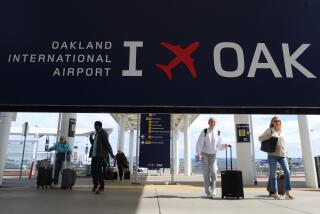S.F. Airport Expansion Proposal Is Tied to Wetlands Restoration
- Share via
San Francisco International Airport officials, after three decades of expansion fights with environmentalists, now think everyone can get what they want: more room for birds.
In this case, that means both the jet-engined and the feathered kinds. Airport commissioners agreed this month to restore a vast swath of wetlands in Sonoma County if they are permitted to fill part of San Francisco Bay for new runways.
Airport officials hope their proposal will allow them to pursue controversial additions to the aged and crowded airport, which they say has not kept up with the region’s growth. Meanwhile, the conversion of a North Bay oat hay farm into a wildlife habitat would restore some of the wetlands lost to development in the area.
“It’s a major opportunity to put back some of the more than 80% of Bay Area wetlands lost over the last 150 years,” said airport spokeswoman Kandace Bender.
Some environmentalists, however, say the plan is for the birds.
They agree that it would be great to restore the wetlands. The oat hay farm is on Skaggs Island, site of a former Navy spy base at the northern end of San Pablo Bay, between Sonoma and Vallejo. But David Madland, project director of the Save San Francisco Bay Assn., is among those who think that wetlands recovery should not be part of an airport deal.
“The only restoration would occur by destroying another part of the bay,” he said of the airport commission plan.
Ringed by serpentine sloughs and peat-dirt levees, Skaggs Island was drained sometime in the first half of the 20th century for farm use. The Navy took over most of the island in 1940, according to Wesley James Haire, whose family has farmed the land since 1941.
During the Cold War, Skaggs Island housed a unit of the Naval Security Group, part of the National Security Agency. High-tech spies, bunkered in a windowless concrete cube, were assigned to monitor Soviet naval activity throughout the North Pacific. Technicians worked around the clock, collecting Morse code messages sent by the Soviets and pinpointing the location of their submarines.
That work faded away with the Soviet Union. The Navy left the island in 1993.
The departure opened the prospect of returning the land to its first inhabitants--birds, fish and other animals. The native wildlife includes two endangered species: the California clapper rail (a bird) and the salt marsh harvest mouse.
Airport commissioners have set aside an initial payment of a little more than $2 million for the proposed restoration of the 1,100-acre parcel. The project would eventually cost $9.4 million if it proceeded, Bender said. A complex financing plan would give the money to a private restoration company that would buy the land from a farmer.
The airport would get a credit for the restoration under state and federal environmental regulations. The credit could be used to compensate for environmental damage caused by runway construction.
Expansion plans for the airport are still being worked out. The runways are 50 years old and just 750 feet apart--less than a fifth of the distance required by current safety regulations. The commission is considering some options other than new runway construction, such as cutting flights or diverting them to other area airports, Bender said.
If airport officials decide to pursue new runways, 300 to 700 acres of the bay would have to be filled, according to commission estimates. Additional runways would have to be approved by 32 local, state and federal agencies, a process that normally takes several years.
The agreement to purchase the Skaggs Island parcel gives the airport five years to close the deal. If new runways are not approved, the airport has no obligation to buy the land, which constitutes about one-fourth of the island.
The oat hay farm now occupying the parcel has posed a problem for a U.S. Interior Department plan to return the government’s portion of Skaggs Island--which is all but the farm--to its original wetlands state.
Doing so without flooding the neighboring farmland would be costly and cumbersome, said Marge Kolar, manager of the San Francisco Bay National Wildlife Refuge for the Interior Department’s Fish and Wildlife Service.
Acquiring the farm for wetlands restoration would solve that problem. “It will make it a lot easier” if the entire island is set aside for wildlife preservation, Kolar said.
Haire said that he had been willing to sell the property for wetlands recovery but that previous offers from the federal government were too low.
“Until the airport offer came through, I never heard a price that reflected the fair value of the land,” he said.
If the airport deal does not work out, Haire said, he will continue to farm on Skaggs Island, producing oat hay for cattle feed.
More to Read
Sign up for Essential California
The most important California stories and recommendations in your inbox every morning.
You may occasionally receive promotional content from the Los Angeles Times.










